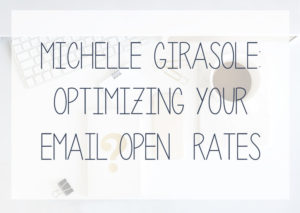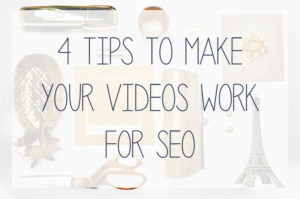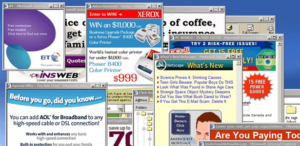 All Entries in the "Strategy" Category
All Entries in the "Strategy" Category
Email – 5 Seconds Can Make or Break Your Next Customer Sale!

Optimizing Your Email OPEN Rates…
Today, we’re (Hub Digital) proud to feature one of our favorite partners and friends, Michelle Girasole of Constant Contact, who is breaking down how to get more attention with your email marketing.
If your customer reads your next email on their mobile device, it will take them just under five seconds to decide if they will read it or delete it. That email had better be good if you want to get their attention and your next sale!
Despite this daunting fact, email is still one of the best values for your marketing dollar. Entrepreneur Magazine just published an article suggesting that email marketing is the “The One Marketing Tool Entrepreneurs Should Focus on for 2017”. It is more effective than many other marketing tactics – not only for building brand awareness, but also for inviting ACTION, the lifeblood of your business. And remember, a customer sale is not the only measurable action, though this is the ultimate end goal. If customers are opening your emails, reading the content, clicking on buttons, links and graphics, asking questions and/or sharing your content on their social media channels, then congratulations! This means you have nurtured a treasure trove of highly engaged subscribers, which will soon lead to sales with consistent, relevant and valuable marketing outreach and sales effort.
If you send an email out and hear only crickets, it is time to rethink your strategy. There are three questions you need to ask in order to achieve success in email marketing:
1) Who cares? You have likely built a large list of email subscribers. Are these people all prospects for business, or just people you know? Do you segment your list and send targeted messages based on their interests, or do all subscribers get the same message? It may be time for a list review. Clean out those addresses that bounce. Segment the folks who click on emails into a “VIP” list that gets special offers or early notice of news or deals. Treat them special, because they are. On average, only 5-18% of subscribers click through, according to Constant Contact, who reviews 200 million customer emails every year. The ones who click through should get special attention, and if you don’t know who they are, you need to find out.
2) What do they care about? What you say in the subject line of your next email should speak directly to the very topic that your customers care the most about. About 1/3 of email subscribers decide to open the email or hit delete, based solely on the content in the subject line! Make your subject line compelling and deliver on the promise of the subject line in the body of your email. Create content based on what they have clicked on in the past – what are their interests? What questions are they asking you at the networking meetings? What problems have you solved for customers this week? Turn those questions and problems into the storytelling that sells your services or products. 80% of your content should be informative, educational and/or entertaining. Only 20% should be sales-oriented, so if you are using your email to deliver discounts and sales offers exclusively, you are missing the point.
3) What happened last time and what do I do next? Most email marketing platforms worth their salt have automated reporting that tell you exactly what happened the last time you sent an email out. Who opened? Who didn’t? Who clicked? What did they click on? What time of day did most people read it? Who came back more than once? What emails bounced back as undeliverable? All of these factors should be studied within 24 hours after you send your email, and careful consideration should be given as to what to do next. There is so much knowledge at our fingertips that can help us pack some power into the next email we send, and yet many of us just look at the open rate as the single factor of success. Read your reports and make marketing decisions based on what you find.
Email is the number one app used on smartphones today. Access to email is everywhere we go, and so we have an opportunity to reach people wherever they are. We’re no longer restricted to communication during daytime working hours to people sitting at their desktops. We can reach them at the coffee shops, football fields and even in their beds. (When was the last time you checked messages one more time, before turning out the light, hmm?) This is a powerful marketing tool, and we must use this power wisely. By using email to nurture your audience, you will build credibility and trust, and invite action. And, people taking action is the only thing that will drive ever your business growth.
Michelle Girasole is an email marketing industry veteran. A marketing professional for 24 years and a Constant Contact solution partner since 2003, Michelle is the only one certified to teach Constant Contact workshops in Rhode Island. She teaches many free workshops for Rhode Island small business and non-profit organizations, many sponsored by SBA/SCORE and the area chambers of commerce. For a calendar of her upcoming workshops click here.
4 Tips To Make Your Video Work For SEO

We’ve said it multiple times, and we’re going to say it again: Video is the king of all content marketing right now. People LOVE video. Customers LOVE video. Social Media LOVES video. But most important, Google LOVES video. So, now that you’re convinced that you want to create great engaging video content that you’re audience will love watching, how can you optimize that amazing video for search? Check out these 4 tips to learn how you can optimize your videos and start driving organic traffic and eyeballs to your content.
1. Start with the content – Researching keywords is something we harp on when it comes to writing blogs, and this is no different when it comes to creating videos. Start brainstorming content ideas around keywords that are popular with your audience. Think about Frequently Asked Questions or things people are searching for within your business vertical. Your videos should answer those questions or explore those topics. Not only will the videos be more popular with your audience, but they will be more likely to show up in more common searches.
2. Now get writing – It may sound counterintuitive to talk about writing when it comes to videos, but there should ALWAYS be text associated with your video. Things like the title of your video, a brief description and even the filename matter. Include your keywords in the filename of your video when save it, before uploading it to your chosen platform (more on that later). Then make sure you write titles and video descriptions that include a brief overview of what your video will be addressing, and don’t forget the keywords! (Are you sick of us talking about those yet…)
3. Choose your hosting platform wisely – First thing’s first, ALWAYS add your video to your website. In most cases you may need to upload it to YouTube or Vimeo first, then embed on your website, but that is all dependent on your own individual website builder. Whether you put it in your blog or on some other page, hosting your video on your website is critical. If you’ve done the SEO work on your website that you should have, (check out this blog to learn more about that topic) your video is only going to benefit. Capitalize on that SEO (in fact, even add to it) by publishing your videos on your website. After that, run through some of the more popular video hosting and social outlets to not only increase your SEO (and links back to your website), but to promote your video to the various audiences.
4. Use your video for good – Ok, so you’ve published your video on your website, Youtube and Vimeo and then promoted it on Facebook, LinkedIn, Twitter and Instagram. Now what? Use your video to start doing the thing it was intended to do, help people! Look through message boards or in groups related to your business and see where people are asking questions around your particular topic. Commenting on these posts with a link back to your video is a great way to drive organic traffic to your video without seeming spammy or annoying. People in these places are looking for information. And you’re here to provide it!
Pop Ups: Don’t Block ‘Em, Unlock ‘Em

Whenever we hear “pop ups,” admittedly our minds still think of pop ups from the early 2000s – back when Windows had that gloomy grey color scheme and all pop ups felt like scams.
Today, we’re reinventing the pop up. They don’t have to be annoying, or scam-y, and they can be a digital marketer’s best friend if you do them correctly. In fact, when done well, users really enjoy relevant pop ups.
So why should you use pop ups?
Well, the largest pull to use pop ups is that they are a great way to generate warm leads that actually want to consume your content. Pop ups are actually proven to drive sales, and websites that have them outperform competitors who don’t. Think about it – by signing up with their email address through your pop up, they’re saying “yes, I want to receive updates from you in my inbox,” which drives sales.
When a user is presented with a pop up, they have to take action – whether that’s saying “yes, here’s my email” or by clicking out of the dialog box. So there’s a 50/50 chance they’ll give you their email address… and an even higher likelihood if you accompany your pop up with some kind of deal.
Pop Ups Best Practices:
- Offer something. A great way to generate leads is by offering a discount, access to your blog or newsletter, or downloadable content, say… a free Ebook to whoever subscribes. Think about it in terms of your own habits – how likely are you to just give a website your email address? Probably pretty unlikely. You’d have to be offered something or be really interested to trust the website enough to give your email address away.
- Don’t make it look pop up-y. There are so many ways that pop ups can look like a beautiful, cohesive component of your website. Be creative and make your ads bold and bright, and make sure it looks nothing like the pop ups we all remember and loathe from the 2000’s.
- Don’t put too many on your site. While users may enjoy relevant pop ups, they don’t enjoy constantly having to click out of several of them while they’re surfing your site, or having the same ones pop up again and again.
There are a few different kinds of pop ups.
- Entry Pop Ups are the ones that show up immediately when you enter a website. These are most effective if you’re a retailer, and we suggest you accompany them with a discount. Caution: an immediate pop up has the potential to deter guests from your site, so you have to be careful and offer a good deal!
-
Timed Pop Ups pop up after a certain amount of time the user spends on the site. These are usually really effective because users have already stayed on your page for a certain length of time, so you know they’re interested in your content. Timed pop ups like “Want content like this sent to your inbox?” or “Download our free Ebook to learn even more” are usually very effective.
- Scroll Pop Ups occur once the user has scrolled down on your webpage or blog post a certain percentage of the page, and won’t pop up before. These are said to be the most effective type of pop up because you know that the user is interested, since they’ve already taken the time to consume your content that much! These will generate the “warmest” leads, or leads that are most likely to end up making a purchase.
Here’s to reinventing pop ups!
And the Future of Digital Marketing Is…

Mobile Apps! That’s right – they’re about to take over in the next few years and here’s how you can jump on board with this trend.
Remember when TVs were SO expensive? How about VCRs and Digital Cameras? In our world (business and marketing) we can easily look back just 10 – or even 5 or 2 -years ago and remember how crazy expensive websites were to build. As technology continues to evolve (at the speed of light lately – especially in this case) Apps are becoming more and more popular because they’re also becoming more affordable to build. And, the use of mobile devices – smart phones AND tablets – has continue to rise. Have you heard the expression ‘everyone carries a TV in their pocket today’? Even how we consume TV has changed and is driven more and more by…yup, you guessed it, Apps! Who here binged on the new Gilmore Girls on Netflix this weekend? Have you seen Narcos, Bluebloods, or The Crown? Do you use Verizon Fios for cable? If so, you probably downloaded the App on your phone so you can watch your favorite shows wherever you are. And it doesn’t just stop at watching video. From weather apps, to games, to loyalty cards, apps are a mobile users best friend. In fact, recent data reports that 90% of consumer’s mobile time is spend in apps. From doctor’s offices, to golf courses, to hotels, to plumbers…there’s an opportunity to build out an App!
Want even more proof? Check out this great article with tons of statistics: http://www.smartinsights.com/mobile-marketing/mobile-marketing-analytics/mobile-marketing-statistics/
How do we know that Apps are here to stay?
How about this prediction? “According to Gartner, by 2017 mobile apps will be downloaded more than 268 billion times.” And, “Non-game app downloads are estimated to grow 23% in the next five years, exceeding $182 billion in 2020.” That’s a huge amount of money and these predictions are coming to fruition at faster speeds than even anticipated with no signs of slowing at all.
What are the benefits of having an App for your business?
While the uses can vary, there are many universal benefits to having an app for your business. Push notifications, while small, can be a great way to connect with your consumer. Apps help you stay top of mind on a device that they’re already on all the time – without them having to stop and search for you. You’ve created a way for your customers to instantly have access to your brand, products or services in a controlled environment. While we love the internet, there is so much out there sometimes your message can get lost. However, people are selective about what they download to their mobile devices. By living on someone’s phone, you’re much more likely to cut through the clutter.
On top of that, think of all the information you usually have to give to register for the apps you download. Apps can be a great way to collect emails or phone numbers to continue your marketing efforts.
Need App ideas?
Committing to creating an app is one thing. Figuring out what to put in it is another. Some popular ideas include loyalty cards, business updates, sales promotions, menus, or coupons. Just to name a few. Do you own a golf course? Maybe your App creates a robust user experience by providing everything from an easy scoring system to tips on the different holes. A retail location? Keep your shoppers updated with the best place to find coupons, sales or previews of new topics. Do you write fashion blogs? Maybe your App gives out trending fashion tips and gives special discounts to boutiques you’re featuring – sounds like a win/win/win for everyone! Have a new product or service launching? Use your app to sell it! Just want to inspire? Fill your app with inspirational posts or pictures that your clients can come back to time after time. Take some time to brainstorm what will be most useful to your clients or customers to create an app experience truly customized for them.










